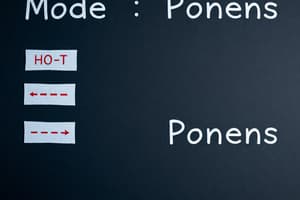Podcast
Questions and Answers
What is the term used in artificial intelligence for generating conclusions from evidence and facts?
What is the term used in artificial intelligence for generating conclusions from evidence and facts?
- Implication
- Inference (correct)
- Contrapositive
- Converse
Which term describes the situation where the right-hand side proposition moves to the left-hand side and vice-versa?
Which term describes the situation where the right-hand side proposition moves to the left-hand side and vice-versa?
- Contrapositive
- Inverse
- Converse (correct)
- Implication
What is the negation of the converse known as?
What is the negation of the converse known as?
- Contrapositive (correct)
- Converse
- Inverse
- Implication
Which of the following is NOT a type of Inference rule?
Which of the following is NOT a type of Inference rule?
What is the representation of logical connectives like 'if...then' in propositional logic?
What is the representation of logical connectives like 'if...then' in propositional logic?
How are compound statements shown to be equivalent using truth tables?
How are compound statements shown to be equivalent using truth tables?
What is the purpose of Unification in logic?
What is the purpose of Unification in logic?
In the example provided, what does the UNIFY algorithm do?
In the example provided, what does the UNIFY algorithm do?
What happens if the UNIFY algorithm fails to find a unifier for two atomic sentences?
What happens if the UNIFY algorithm fails to find a unifier for two atomic sentences?
What does Unification rely on as part of the replacement process?
What does Unification rely on as part of the replacement process?
How is Unification related to First Order Inference (FOI) algorithms?
How is Unification related to First Order Inference (FOI) algorithms?
What is the outcome of applying a unifier to two atomic sentences using the UNIFY algorithm?
What is the outcome of applying a unifier to two atomic sentences using the UNIFY algorithm?
What does Modus Ponens state?
What does Modus Ponens state?
Which statement best represents Modus Tollens?
Which statement best represents Modus Tollens?
In Hypothetical Syllogism, what can be inferred when P → R and Q → R are both true?
In Hypothetical Syllogism, what can be inferred when P → R and Q → R are both true?
What does Disjunctive Syllogism state?
What does Disjunctive Syllogism state?
How can you best describe the relationship between Modus Ponens and Modus Tollens?
How can you best describe the relationship between Modus Ponens and Modus Tollens?
In the context of logical inference, what does the statement 'P→Q / P / ∴Q' represent?
In the context of logical inference, what does the statement 'P→Q / P / ∴Q' represent?
What is the benefit of combining declarative and procedural approaches in building an agent?
What is the benefit of combining declarative and procedural approaches in building an agent?
Which action does the 'TELL' function perform in a Knowledge-Based Agent (KBA)?
Which action does the 'TELL' function perform in a Knowledge-Based Agent (KBA)?
What does the generic KBA program do when it receives input percept?
What does the generic KBA program do when it receives input percept?
How does a Knowledge-Based Agent (KBA) utilize the 'ASK' function?
How does a Knowledge-Based Agent (KBA) utilize the 'ASK' function?
What does the counter 't' represent in the generic KBA program?
What does the counter 't' represent in the generic KBA program?
What is the purpose of the 'Perform' action in a Knowledge-Based Agent (KBA)?
What is the purpose of the 'Perform' action in a Knowledge-Based Agent (KBA)?
What is a free variable in First Order Logic?
What is a free variable in First Order Logic?
Which of the following is an example of a bound variable?
Which of the following is an example of a bound variable?
What is substitution in First Order Logic?
What is substitution in First Order Logic?
How is equality used in First Order Logic?
How is equality used in First Order Logic?
What does the equation F[a/x] represent in First Order Logic?
What does the equation F[a/x] represent in First Order Logic?
How does First Order Logic use equality when comparing terms?
How does First Order Logic use equality when comparing terms?
Flashcards are hidden until you start studying




